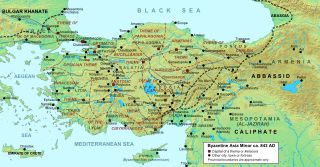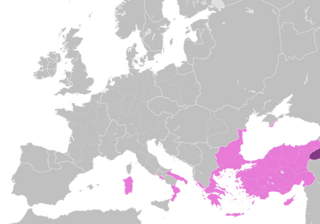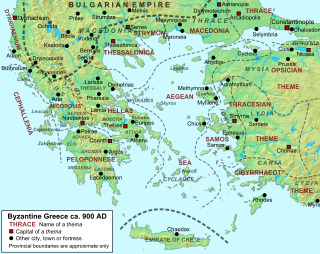
The Battle of Bathys Ryax was fought in 872 or 878 between the Byzantine Empire and the Paulicians. The Paulicians were a Christian sect which—persecuted by the Byzantine state—had established a separate principality at Tephrike on Byzantium's eastern border and collaborated with the Muslim emirates of the Thughur, the Abbasid Caliphate's borderlands, against the Empire. The battle was a decisive Byzantine victory, resulting in the rout of the Paulician army and the death of its leader, Chrysocheir. This event destroyed the power of the Paulician state and removed a major threat to Byzantium, heralding the fall of Tephrike itself and the annexation of the Paulician principality shortly after.
Constantine Lips was a Byzantine aristocrat and admiral who lived in the later 9th and early 10th centuries. He was killed in 917 at the Battle of Acheloos against Bulgaria. Constantine Lips is most notable for his foundation of the convent bearing his name at Constantinople.
John Kourkouas, also transliterated as Kurkuas or Curcuas, was one of the most important generals of the Byzantine Empire. His success in battles against the Muslim states in the East reversed the course of the centuries-long Arab–Byzantine wars and set the stage for Byzantium's eastern conquests later in the century.

Charsianon was the name of a Byzantine fortress and the corresponding theme in the region of Cappadocia in eastern Anatolia.

The Byzantine Empire was ruled by the Isaurian dynasty from 717 to 802. The Isaurian emperors were successful in defending and consolidating the empire against the caliphates after the onslaught of the early Muslim conquests, but were less successful in Europe, where they suffered setbacks against the Bulgars, had to give up the Exarchate of Ravenna, and lost influence over Italy and the papacy to the growing power of the Franks.

Leo Phokas or Phocas was a prominent Byzantine general who scored a number of successes in the eastern frontier in the mid-10th century alongside his older brother, the Emperor Nikephoros II Phokas. He served as chief minister during his brother's reign, but was dismissed and imprisoned by his successor, John Tzimiskes.

The Armeniac Theme, more properly the Theme of the Armeniacs, was a Byzantine theme located in northeastern Asia Minor.
Melias or Mleh was an Armenian prince who entered Byzantine service and became a distinguished general, founding the theme of Lykandos and participating in the campaigns of John Kourkouas against the Arabs.
ʿUmar ibn ʿAbdallāh ibn Marwān or ʿAmr ibn ʿUbaydallāh ibn Marwān, surnamed al-Aqtaʾ, and found as Amer or Ambros in Byzantine sources, was the semi-independent Arab emir of Malatya (Melitene) from the 830s until his death in the Battle of Lalakaon on 3 September 863. During this time, he was one of the greatest threats to the Byzantine Empire on its eastern frontier, and became a prominent figure in later Arabic and Turkish epic literature.
Eustathios Maleinos was a leading Byzantine general and one of the wealthiest and most influential members of the Anatolian military aristocracy during the late 10th century. He held senior administrative and military posts in the East, and was involved in the aristocratic rebellions against Emperor Basil II, fighting against Bardas Skleros but supporting the revolt of his nephew Bardas Phokas. After the failure of the latter, he was not punished, but his immense wealth caused his eventual downfall, as Basil II confined him to a mansion in Constantinople and confiscated his wealth after his death.

Mesopotamia was the name of a Byzantine theme located in what is today eastern Turkey. It should not be confused with the region of Mesopotamia or with the older Roman and early Byzantine province of Mesopotamia. The Byzantine theme was located between the rivers Arsanias and Çimisgezek.
Phokas or Phocas (Latinized), feminine form Phokaina or Phocaena, was the name of a Byzantine aristocratic clan from Cappadocia, which in the 9th and 10th centuries provided a series of high-ranking generals and an emperor, Nikephoros II Phokas. Its members and their clients monopolized the high-command positions of the Byzantine army for much of the 10th century and led the successful Byzantine offensive against the Arabs in the East. As one of the leading families of the Anatolian military aristocracy, the Phokades were also involved in a series of rebellions that laid claim to power and challenged the emperors at Constantinople. Their power was eventually broken by Basil II, and the family declined in importance after the 11th century.

The Skleros, latinized Sclerus, feminine form Skleraina (Σκλήραινα), Latinized Scleraena, was a noble Byzantine family active mostly in the 9th–11th centuries as members of the military aristocracy, and as civil functionaries thereafter.

The Theme of Cappadocia was a Byzantine theme encompassing the southern portion of the namesake region from the early 9th to the late 11th centuries.

The Theme of Cephallenia or Cephalonia was a Byzantine theme located in western Greece, comprising the Ionian Islands, and extant from the 8th century until partially conquered by the Kingdom of Sicily in 1185.

The Theme of Sebasteia was a military-civilian province of the Byzantine Empire located in northeastern Cappadocia and Armenia Minor, in modern Turkey. It was established as a theme in 911 and endured until its fall to the Seljuk Turks in the aftermath of the Battle of Manzikert in 1071.

The Theme of Koloneia was a small military-civilian province of the Byzantine Empire located in northern Cappadocia and the southern Pontus, in modern Turkey. It was founded sometime in the mid-9th century and survived until it was conquered by the Seljuk Turks soon after the Battle of Manzikert in 1071.
Eustathios Argyros was a Byzantine aristocrat and one of the most prominent generals under Emperor Leo VI the Wise. The first member of the Argyros family to rise to high posts, he fought with distinction against the Arabs in the east, before being disgraced ca. 907, possibly in connection with the flight of Andronikos Doukas to the Arabs. Rehabilitated soon after, he was appointed as strategos of Charsianon, from which post he oversaw the settlement of Armenian lords as march-wardens along the Empire's eastern frontier. Promoted to commander of the imperial bodyguard in late 908, he again fell into disgrace shortly after and died of poison on his way to his estates.
Melias was a Byzantine general of Armenian origin, active in the wars against the Arabs in the east under Nikephoros II Phokas and John I Tzimiskes. He was defeated before Amid in 973 by the Hamdanids and died in captivity shortly after.

The Duchy of Antioch was a Byzantine territory ruled by a duke (dux) appointed by and under the authority of the emperor. It was founded in 969 after the reconquest of Antioch by imperial troops and existed until December 1084, when Suleiman ibn Qutalmish of the Sultanate of Rum conquered the ducal capital.











